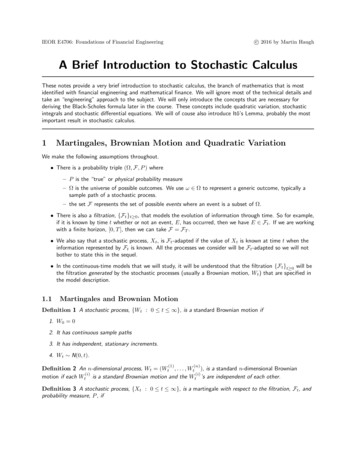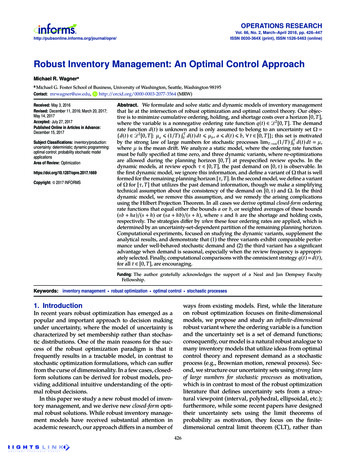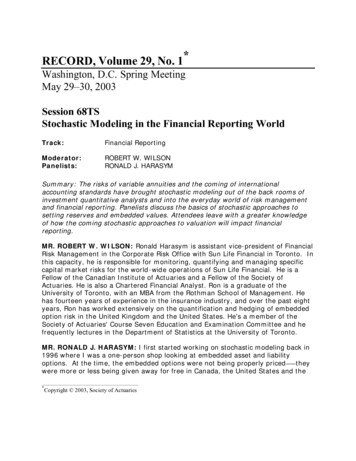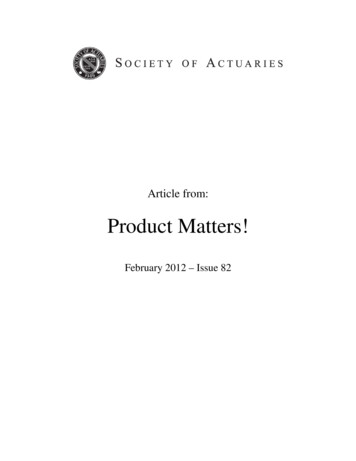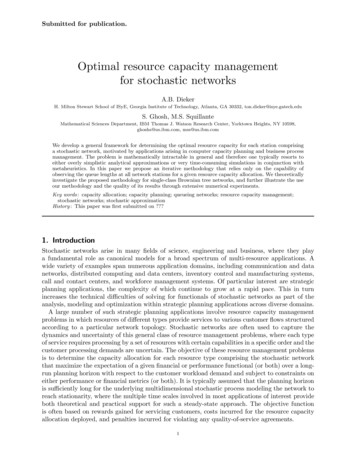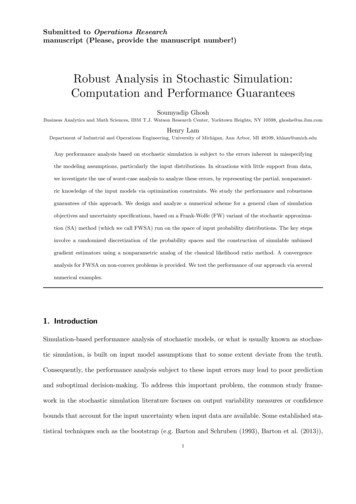
Transcription
Submitted to Operations Researchmanuscript (Please, provide the manuscript number!)Robust Analysis in Stochastic Simulation:Computation and Performance GuaranteesSoumyadip GhoshBusiness Analytics and Math Sciences, IBM T.J. Watson Research Center, Yorktown Heights, NY 10598, ghoshs@us.ibm.comHenry LamDepartment of Industrial and Operations Engineering, University of Michigan, Ann Arbor, MI 48109, khlam@umich.eduAny performance analysis based on stochastic simulation is subject to the errors inherent in misspecifyingthe modeling assumptions, particularly the input distributions. In situations with little support from data,we investigate the use of worst-case analysis to analyze these errors, by representing the partial, nonparametric knowledge of the input models via optimization constraints. We study the performance and robustnessguarantees of this approach. We design and analyze a numerical scheme for a general class of simulationobjectives and uncertainty specifications, based on a Frank-Wolfe (FW) variant of the stochastic approximation (SA) method (which we call FWSA) run on the space of input probability distributions. The key stepsinvolve a randomized discretization of the probability spaces and the construction of simulable unbiasedgradient estimators using a nonparametric analog of the classical likelihood ratio method. A convergenceanalysis for FWSA on non-convex problems is provided. We test the performance of our approach via severalnumerical examples.1. IntroductionSimulation-based performance analysis of stochastic models, or what is usually known as stochastic simulation, is built on input model assumptions that to some extent deviate from the truth.Consequently, the performance analysis subject to these input errors may lead to poor predictionand suboptimal decision-making. To address this important problem, the common study framework in the stochastic simulation literature focuses on output variability measures or confidencebounds that account for the input uncertainty when input data are available. Some established statistical techniques such as the bootstrap (e.g. Barton and Schruben (1993), Barton et al. (2013)),1
Ghosh and Lam: Robust Analysis in Stochastic SimulationArticle submitted to Operations Research; manuscript no. (Please, provide the manuscript number!)2goodness-of-fit tests (e.g. Banks et al. (2009)), Bayesian inference and model selection (e.g. Chick(2001), Zouaoui and Wilson (2004)) and the delta method (e.g., Cheng and Holland (1998, 2004))etc. have been proposed and have proven effective in many situations.In this paper, we focus on a setting that diverges from most past literature: we are primarilyinterested in situations with insufficient data, or when the modeler wants to assess risk beyondwhat the data or the model indicates. Such situations can arise when the system, service targetor operational policy in study is at a testing stage without much prior experience. To find reliableestimates for the output quantities in these settings, we investigate a worst-case approach operatingon the space of input models. In this framework, the modeler represents the partial and nonparametric beliefs about the input model as constraints, and computes tight worst-case bounds amongall models that satisfy them. More precisely, let Z(P 1 , . . . , P m ) be a performance measure thatdepends on m input models, each generated from a probability distribution P i . The formulationfor computing the worst-case bounds areminP i U i ,i 1,.,mZ(P 1 , . . . , P m )andmaxP i U i ,i 1,.,mZ(P 1 , . . . , P m )(1)The set U i encodes the collection of all possible P i from the knowledge of the modeler. The decisionvariables in the optimizations in (1) are the unknown models P i , i 1, . . . , m.The primary motivation for using (1) is the robustness against model misspecification, wherea proper construction of the set U i avoids making specific assumptions beyond the modeler’sknowledge. The following three examples motivate and explain further.Example 1 (Robust bounds under expert opinion). When little information is available foran input model, a common practice in stochastic simulation is to summarize its range (say [a, b])and mean (say µ; or sometimes mode) as a triangular distribution (Banks et al. (2009), Chapter5), where the base of the triangle denotes the range and the position of the peak is calibrated fromthe mean. This specific distribution, while easy to use, only crudely describes the knowledge of themodeler and may deviate from the true distribution, even if a, b, µ are correctly specified. Instead,usingU i {P i : EP i [X i ] µ, supp P i [a, b]}(2)
Ghosh and Lam: Robust Analysis in Stochastic SimulationArticle submitted to Operations Research; manuscript no. (Please, provide the manuscript number!)3in formulation (1), where X i is the random variate, EP i [·] is the expectation under P i , and supp P iis the support of P i , will give a valid interval that covers the true performance measure whenevera, b, µ are correctly specified. Moreover, when these parameters are not fully known but insteadspecified within a range, (2) can be relaxed toU i {P i : µ EP i [X i ] µ, supp X i [a, b]}where [µ, µ] denotes the range of the mean and a, b denote the lower estimate of the lower supportend and upper estimate of the upper support end respectively. The resulting bound will cover thetruth as long as these ranges are supplied correctly. Example 2 (Dependency modeling). In constructing dependent input models, commonapproaches in the simulation literature fit the marginal description and the correlation of a multivariate model to a specified family. Examples include Gaussian copula (e.g., Lurie and Goldberg(1998), Channouf and L’Ecuyer (2009); also known as normal-to-anything (NORTA), e.g. Carioand Nelson (1997)) and chessboard distribution (Ghosh and Henderson (2002)) that uses a domaindiscretization. These distributions are correctly constructed up to their marginal description andcorrelation, provided that these information are correctly specified. However, dependency structurebeyond correlation can imply errors on these approaches (e.g., Lam (2016c)). Formulation (1) canbe used to get bounds that address such dependency. For example, suppose P i is a bivariate inputmodel with marginal distributions P i,1 , P i,2 , marginal means µi,1 , µi,2 and covariance ρi . We cansetU i {P i : PP i,1 (X i,1 qji,1 ) νj1 , j 1, . . . , l1 , PP i,2 (X i,2 qji,2 ) νj2 , j 1, . . . , l2 , E[X i,1 X i,2 ] ρi µi,1 µi,2 }where (X i,1 , X i,2 ) denote the random vector under P i , and qji,1 , qji,2 , νji,1 , νji,2 are pre-specified quantiles and probabilities of the respective marginal distributions. Unlike previous approaches, (1)outputs correct bounds on the truth given correctly specified marginal quantiles and correlation,regardless of the dependency structure.
Ghosh and Lam: Robust Analysis in Stochastic SimulationArticle submitted to Operations Research; manuscript no. (Please, provide the manuscript number!)4Example 3 (Model risk). Model risk refers broadly to the uncertainty in analysis arising fromthe adopted model not being fully accurate. This inaccuracy occurs as the adopted model (oftenknown as the baseline model), typically obtained from the best statistical fit or expert opinion,deviates from the truth due to the real-world non-stationarity and the lack of full modeling knowledge or capability. To assess model risk, a recently surging literature studies the use of statisticaldistance as a measurement of model discrepancy (e.g., Glasserman and Xu (2014), Lam (2016b)).Given the baseline model Pbi , the idea is to represent the uncertainty in terms of the distance awayfrom the baseline via a neighborhood ballU i {P i : d(P i , Pbi ) η i }(3)where d is a distance defined on the nonparametric space of distributions (i.e., without restrictingto any parametric families). The bounds drawn from formulation (1) assesses the effect of modelrisk due to the input models, tuned by the ball size parameter η i that denotes the uncertainty level.Besides risk assessment, this approach can also be used to obtain consistent confidence boundsfor the true performance measure, when Pbi is taken as the empirical distribution and η and d arechosen suitably. For example, when d is a φ-divergence and the model is finite discrete, one canchoose η i as a scaled χ2 -quantile. When d is the sup-norm and the model is continuous, then onecan choose η i as the quantile of a Kolmogorov-Smirnov statistics. The statistical properties of thesechoices are endowed from the associated goodness-of-fit tests (Ben-Tal et al. (2013), Bertsimaset al. (2014)). Our worst-case approach is inspired from the literature of robust optimization (Ben-Tal et al.(2009), Bertsimas et al. (2011)), which considers decision-making under uncertainty and advocatesoptimizing decisions over worst-case scenarios. In particular, when the uncertainty lies in the probability distributions that govern a stochastic problem, the decision is made to optimize under theworst-case distributions. This approach has been used widely in robust stochastic control (e.g.Hansen and Sargent (2008), Petersen et al. (2000)) and distributionally robust optimization (e.g.
Ghosh and Lam: Robust Analysis in Stochastic SimulationArticle submitted to Operations Research; manuscript no. (Please, provide the manuscript number!)5Delage and Ye (2010), Lim et al. (2006)). It has also appeared in so-called robust simulation orrobust Monte Carlo in the simulation literature (Hu et al. (2012), Glasserman and Xu (2014)).However, the methodologies presented in these literature focus on structured problems where theobjective function is tractable, such as linear or linearly decomposable. In contrast, Z(·) for mostproblems in stochastic simulation is nonlinear, unstructured and is only amenable to simulation,obstructing the direct adaption of the existing methods. In view of this, our main objective is todesign an efficient simulation-based method to compute the worst-case bounds for formulation (1)that can be applied to broad classes of simulation models and input uncertainty representations.1.1. Our ContributionsWe study a simulation-based iterative procedure for the worst-case optimizations (1), based on amodified version of the celebrated stochastic approximation (SA) method (e.g. Kushner and Yin(2003)). Because of the iterative nature, it is difficult to directly operate on the space of continuousdistributions except in very special cases. Thus, our first contribution is to provide a randomizeddiscretization scheme that can provably approximate the continuous counterpart. This allows oneto focus on the space of discrete distributions on fixed support points as the decision variable forfeeding into our SA algorithm.We develop the SA method in several aspects. First, we construct an unbiased gradient estimatorfor Z based on the idea of the Gateaux derivative for functionals of probability distributions(Serfling (2009)), which is used to obtain the direction in each subsequent iterate in the SA scheme.The need for such construction is motivated by the difficulty in naı̈ve implementation of standardgradient estimators: An arbitrary perturbation of a probability distribution, which is the decisionvariable in the optimization, may shoot outside the probability simplex and results in a gradientthat does not bear any probabilistic meaning and subsequently does not support simulation-basedestimation. Our approach effectively restricts the direction of perturbation to within a probabilitysimplex so that the gradient is guaranteed to be simulable. We justify it as a nonparametric version
6Ghosh and Lam: Robust Analysis in Stochastic SimulationArticle submitted to Operations Research; manuscript no. (Please, provide the manuscript number!)of the classical likelihood ratio method (also called the score function method) (Glynn (1990),Reiman and Weiss (1989), Rubinstein (1986)).Next, we design and analyze our SA scheme under the uncertainty constraints. We choose touse a stochastic counterpart of the so-called Frank-Wolfe (FW) method (Frank and Wolfe (1956)),known synonymously as the conditional gradient method in deterministic nonlinear programming.For convenience we call our scheme FWSA. Note that a standard SA iteration follows the estimatedgradient up to a pre-specified step size to find the next candidate iterate. When the formulationincludes constraints, the common approach in the SA literature projects the candidate solutiononto the feasible region in order to define the next iterate (e.g. Kushner and Yin (2003)). Instead,our method looks in advance for a feasible direction along which the next iterate is guaranteed to liein the (convex) feasible region. In order to find this feasible direction, an optimization subproblemwith a linear objective function is solved in each iteration. We base our choice of using FWSAon its computational benefit in solving these subproblems, as their linear objectives allow efficientsolution scheme for high-dimensional decision variables for many choices of the set U i .We characterize the convergence rate of FWSA in terms of the step size and the number ofsimulation replications used to estimate the gradient at each iteration. The form of our convergencebounds suggests prescriptions for the step-size and sample-size sequences that are efficient withrespect to the cumulative number of sample paths simulated to generate all the gradients until thecurrent iterate. The literature on the stochastic FW methods for non-convex problems is small.Kushner (1974) proves almost sure convergence under assumptions that can prescribe algorithmicspecifications only for one-dimensional settings. During the review process of this paper, two otherconvergence rate studies Reddi et al. (2016) and Lafond et al. (2016) have appeared. Both ofthem assume the so-called G-Lipschitz condition on the gradient estimator that does not apply toour setting. Consequently, our obtained convergence rates are generally inferior to their results.Nonetheless, we shall argue that our rates almost match theirs under stronger assumptions on thebehavior of the iterates that we will discuss.
Ghosh and Lam: Robust Analysis in Stochastic SimulationArticle submitted to Operations Research; manuscript no. (Please, provide the manuscript number!)7Finally, we provide numerical validation of our approach using two sets of experiments, onetesting the performance of our proposed randomized discretization strategy, and one on the convergence of FWSA. We also illustrate the impacts from the choices of constraints and investigatethe form of the resulting worst-case input distributions in these examples.1.2. Literature ReviewWe briefly survey three lines of related work. First, our paper is related to the large literatureon input model uncertainty. In the parametric regime, studies have focused on the constructionof confidence intervals or variance decompositions to account for both parameter and stochasticuncertainty using data, via for instance the delta method (Cheng and Holland (1998, 2004)), thebootstrap (Barton et al. (2013), Cheng and Holloand (1997)), Bayesian approaches (Zouaoui andWilson (2003), Xie et al. (2014), Saltelli et al. (2010, 2008)), and metamodel-assisted analysis (Xieet al. (2014, 2015)). Model selection beyond a single parametric model can be handled throughgoodness-of-fit or Bayesian model selection and averaging (Chick (2001), Zouaoui and Wilson(2004)). Fully nonparametric approaches using the bootstrap have also been investigated (Bartonand Schruben (1993, 2001), Song and Nelson (2015)).Second, formulation (1) relates to the literature on robust stochastic control (Petersen et al.(2000), Iyengar (2005), Nilim and El Ghaoui (2005)) and distributionally robust optimization(Delage and Ye (2010), Goh and Sim (2010), Ben-Tal et al. (2013)), where the focus is to makedecision rules under stochastic environments that are robust against the ambiguity of the underlyingprobability distributions. This is usually cast in the form of a minimax problem where the innermaximization is over the space of distributions. This idea has spanned across multiple areas likeeconomics (Hansen and Sargent (2001, 2008)), finance (Glasserman and Xu (2013), Lim et al.(2011)), queueing (Jain et al. (2010)) and dynamic pricing (Lim and Shanthikumar (2007)). In thesimulation context, Hu et al. (2012) compared different global warming policies using Gaussianmodels with uncertain mean and covariance information and coined the term “robust simulation”in their study. Glasserman and Xu (2014) and Lam (2016b) studied approximation methods for
Ghosh and Lam: Robust Analysis in Stochastic SimulationArticle submitted to Operations Research; manuscript no. (Please, provide the manuscript number!)8distance-based constraints in model risk quantification, via sample average approximation andinfinitesimal approximation respectively. Simulation optimization under input uncertainty has alsobeen studied in the framework of robust optimization (Fan et al. (2013), Ryzhov et al. (2012))and via the closely related approach using risk measure (Qian et al. (2015), Zhou and Xie (2015)).Lastly, optimizations over probability distributions have also arisen as so-called generalized momentproblems, applied to decision analysis (Smith (1995, 1993), Bertsimas and Popescu (2005)) andstochastic programming (Birge and Wets (1987)).Our algorithm relates to the literature on the FW method (Frank and Wolfe (1956)) and constrained SA. The former is a nonlinear programming technique initially proposed for convex optimization, based on sequential linearization of the objective function using the gradient at thesolution iterate. SA is the stochastic counterpart of gradient-based method under noisy observations. The classical work of Canon and Cullum (1968), Dunn (1979) and Dunn (1980) analyzedconvergence properties of FW for deterministic convex programs. Recently, Jaggi (2013), Freundand Grigas (2014) and Hazan and Luo (2016) carried out new finite-time analysis for the FWmethod motivated by machine learning applications. For stochastic FW on non-convex problems,Kushner (1974) focused on almost sure convergence based on a set of assumptions about the probabilistic behavior of the iterations, which were then used to tune the algorithm for one-dimensionalproblems. Recently, while this paper was under review, Reddi et al. (2016) provided a complexityanalysis in terms of the sample size in estimating gradients and the number of calls of the linearoptimization routine. Lafond et al. (2016) studied the performance in terms of regret in an onlinesetting. Both Reddi et al. (2016) and Lafond et al. (2016) relied on the G-Lipschitz condition thatour gradient estimator violated. Other types of constrained SA schemes include the Lagrangianmethod (Buche and Kushner (2002)) and mirror descent SA (Nemirovski et al. (2009)). Lastly, general convergence results for SA can be found in Fu (1994), Kushner and Yin (2003) and Pasupathyand Kim (2011).
Ghosh and Lam: Robust Analysis in Stochastic SimulationArticle submitted to Operations Research; manuscript no. (Please, provide the manuscript number!)91.3. Organization of the PaperThe remainder of this paper is organized as follows. Section 2 describes our formulation andassumptions. Section 3 presents our performance guarantees and discretization strategy. Section 4focuses on gradient estimation on the space of probability distributions. Section 5 introduces theFWSA procedure. Section 6 presents theoretical convergence results on FWSA. Section 7 showssome numerical performance. Section 8 concludes and suggests future research. Finally, AppendixEC.1 gives the remaining proofs of our theorems.2. Formulation and AssumptionsWe focus on Z(P 1 , . . . , P m ) that is a finite horizon performance measure generated from i.i.d.replications from the independent input models P 1 , . . . , P m . Let Xi (Xti )t 1,.,T i be T i i.i.d.irandom variables on the space X i Rv , each generated under P i . The performance measure canbe written as111mmZ(P , . . . , P ) EP 1 ,.,P m [h(X , . . . , X )] ZZ···1mh(x , . . . , x )TYt 1where h(·) :Qmi 1 (Xi Ti)mdP (x1t ) · · ·TYdP (xm(4)t )t 1 R is a cost function, and EP 1 ,.,P m [·] denotes the expectation associatedwith the generation of the i.i.d. replications. We assume that h(·) can be evaluated by the computergiven the inputs. In other words, the performance measure (4) can be approximated by runningsimulation.(4) is the stylized representation for transient performance measures in discrete-event simulation.For example, X1 and X2 can be the sequences of interarrival and service times in a queue, and P 1and P 2 are the interarrival time and service time distributions. When h(X1 , X2 ) is the indicatorfunction of the waiting time exceeding a threshold, (4) will denote the expected waiting time.Next we discuss the constraints in (1). Following the terminology in robust optimization, we callU i the uncertainty set for the i-th input model. Motivated by the examples in the Introduction,we focus on two types of convex uncertainty sets:
10Ghosh and Lam: Robust Analysis in Stochastic SimulationArticle submitted to Operations Research; manuscript no. (Please, provide the manuscript number!)1. Moment and support constraints: We considerU i {P i : EP i [fli (X i )] µil , l 1, . . . , si , supp P i Ai }(5)where X i is a generic random variable under distribution P i , fli : X i R, and Ai X i . For instance,when X i R, fli (x) being x or x2 denotes the first two moments. When X i R2 , fli (x1 , x2 ) x1 x2denotes the cross-moment. Equalities can also be represented via (5) by including EP i [ fli (X i )] µil . Thus the uncertainty set (5) covers Examples 1 and 2 in the Introduction.Furthermore, the neighborhood measured by certain types of statistical distance (Example 3)can also be cast as (5). For instance, suppose d is induced by the sup-norm on the distributionfunction on R. Suppose P i is a continuous distribution and the baseline distribution Pbi is discretewith support points yj , j 1, . . . , ni . The constraintsup F i (x) Fbi (x) η i(6)x Rwhere F i and Fbi denote the distribution functions for P i and Pbi respectively, can be reformulatedasFbi (yj ) η i F i (yj ) Fbi (yj ) η i , l 1, . . . , niwhere Fbi (yj ) and Fbi (yj ) denote the left and right limits of Fbi at yj , by using the monotonicityof distribution functions. ThusU i {P i : Fbi (yj ) η i E i [I(X i yj )] Fbi (yj ) η i , j 1, . . . , ni , supp P i R}where I(·) denotes the indicator function, falls into the form of (5). Bertsimas et al. (2014) considers this reformulation for constructing uncertainty sets for stochastic optimization problems,and suggests to select η i as the quantile of Kolmogorov-Smirnov statistics if Fbi is the empiricaldistribution function constructed from i.i.d. data.2. Neighborhood of a baseline model measured by φ-divergence: ConsiderU i {P i : dφ (P i , Pbi ) η i }(7)
Ghosh and Lam: Robust Analysis in Stochastic SimulationArticle submitted to Operations Research; manuscript no. (Please, provide the manuscript number!)11where dφ (P i , Pbi ) denotes the φ-divergence from a baseline distribution Pbi given bydφ (Pi, Pbi )Z dP iφdPbi dPbiwhich is finite only when P i is absolutely continuous with respect to Pbi . The function φ is a convexfunction satisfying φ(1) 0. This family covers many widely used distances. Common examples areφ(x) x log x x 1 giving the KL divergence, φ(x) (x 1)2 giving the (modified) χ2 -distance,and φ(x) (1 θ θx xθ )/(θ(1 θ)), θ 6 0, 1 giving the Cressie-Read divergence. Details ofφ-divergence can be found in, e.g., Pardo (2005) and Ben-Tal et al. (2013).As precursed in the Introduction, in the context of simulation analysis where (P 1 , . . . , P m ) arethe input models, Z(·) in (4) is in general a complex nonlinear function. This raises challengesin solving (1) beyond the literature of robust control and optimization that considers typicallymore tractable objectives. Indeed, if Z(·) is a linear function in P i ’s, then optimizing over the twotypes of uncertainty sets above can both be cast as specialized classes of convex programs thatcan be efficiently solved. But linear Z(·) is too restrictive to describe the input-output relationin simulation. To handle a broader class of Z(·) and to address its simulation-based nature, wepropose to use a stochastic iterative method. The next sections will discuss our methodology inrelation to the performance guarantees provided by (1).3. Performance Guarantees and Discretization StrategySuppose there is a “ground true” distribution P0i for each input model. Let Z and Z be theminimum and maximum values of the worst-case optimizations (1). Let Z0 be the true performancemeasure, i.e. Z0 Z(P01 , . . . , P0m ). The following highlights an immediate implication of using (1):Theorem 1. If P0i U i for all i, then Z Z0 Z .In other words, the bounds from the worst-case optimizations form an interval that covers thetrue performance measure if the uncertainty sets contain the true distributions.We discuss a discretization strategy for the worst-case optimizations for continuous input distributions. We will show that, by replacing the continuous distribution with a discrete distribution on
Ghosh and Lam: Robust Analysis in Stochastic SimulationArticle submitted to Operations Research; manuscript no. (Please, provide the manuscript number!)12support points that are initially sampled from some suitably chosen distribution, we can recoverthe guarantee in Theorem 1 up to a small error. The motivation for using discretization comes fromthe challenges in handling decision variables in the form of continuous distributions when runningour iterative optimization scheme proposed later.We focus on the two uncertainty sets (5) and (7). The following states our guarantee:Theorem 2. Consider Z(P 1 , . . . , P m ) in (4). Assume h is bounded a.s. Suppose ni , i 1, . . . , mand n are positive numbers such that C ni /n C for all i for some 0 C, C . Consider theoptimizationsẐ minZ(P 1 , . . . , P m )Ẑ andP i Û i ,i 1,.,mmaxZ(P 1 , . . . , P m )(8)P i Û i ,i 1,.,mSuppose that for each i, one of the two cases occurs:1.Û i {P i : EP i [fli (X i )] µil , l 1, . . . , si , supp P i {y1i , . . . , yni i }}(9)where {y1i , . . . , yni i } are ni observations drawn from a distribution Qi such that the true distributionP0i is absolutely continuous with respect to Qi with Li dP0i /dQi satisfying kLi k , wherek · k denotes the essential supremum norm. Moreover, assume that P0i satisfies EP0i [fli (X i )] µiland EP0i [fli (X i )2 ] for all l 1, . . . , si .2.Û i {P i : dφ (P i , P̂bi ) η i }(10)where P̂bi denotes the empirical distribution drawn from ni observations from a baseline Pbi .Assume that Li dP0i /dPbi satisfies kLi k . Moreover, assume P0i satisfies dφ (P0i , Pbi ) η i andEP0i [φ(Li )2 ] . Additionally, assume φ0 (x) for all x R .Then Ẑ Z0 Op1 n Ẑ (11)
Ghosh and Lam: Robust Analysis in Stochastic SimulationArticle submitted to Operations Research; manuscript no. (Please, provide the manuscript number!)13Theorem 2 is proved in Appendix EC.1. We have a few immediate remarks:1. Optimizations (8) are the sample counterparts of the original worst-case optimizations (1)with uncertainty sets given by (5) or (7). These sample counterparts optimize discrete distributionsover support points that are sampled from either Qi or Pbi depending on the type of uncertainty.Roughly speaking, Theorem 2 guarantees that, if the original worst-case optimizations give validcovering bounds for the true performance measure (in the spirit of Theorem 1), then so are the sample counterparts, up to an error Op (1/ n) where n denotes the order of the sample size usedto construct the sets of support points.2. The condition kLi k implies that Qi or Pbi has a tail at least as heavy as P0i . In practice,the tail of the true distribution P0i is not exactly known a priori. This means that it is safer tosample the support points from a heavy-tailed distribution when moment constraints are imposed,and to use a heavy-tailed baseline distribution in the case of φ-divergence neighborhood.3. The conditions EP0i [fli (X i )] µil and dφ (P0i , Pbi ) η i state that EP0i [fli (X i )] and dφ (P0i , Pbi ) arein the interior of {(z1 , . . . , zsi ) : zl µil , l 1, . . . , si } and {z : z η i } respectively. These conditionsguarantee that P0 projected on a sample approximation of the support is feasible for (8), whichhelps lead to the guarantee (11). In general, the closer P0 is to the boundary of the uncertaintyset, i.e., the smaller the values of µil EP0i [fli (X i )] and η i dφ (P0i , Pbi ), the larger the sample sizeis needed for the asymptotic behavior in (11) to kick in, a fact that is not revealed explicitly inTheorem 2. One way to control this required sample size is to expand the uncertainty set by asmall margin, say 0, i.e., use EP i [fli (X i )] µil and dφ (P i , Pbi ) η i , in (9) and (10). Notethat, in the case of moment equality constraint, say EP i [fli (X i )] µil , one does have to deliberatelyrelax the constraint to µil EP i [fli (X i )] µil for the interior-point conditions to hold.A probabilistic analog of Theorem 1 is:Theorem 3. Suppose U i contains the true distribution P0i for all i with confidence 1 α, i.e. P(U i 3P0i for all i 1, . . . , m) 1 α, then P(Z Z0 Z ) 1 α, where P denotes the probabilitygenerated from a combination of data and prior belief.
14Ghosh and Lam: Robust Analysis in Sto
b is taken as the empirical distribution and and dare chosen suitably. For example, when dis a -divergence and the model is nite discrete, one can choose i as a scaled 2-quantile. When dis the sup-norm and the model is continuous, then one can choose ias the quantile of a Kolmogorov-Smirnov statistics. The statistical properties of these
